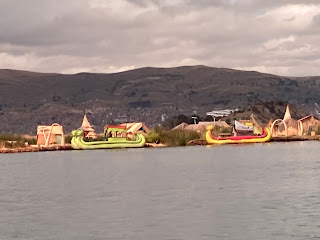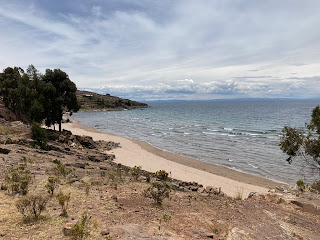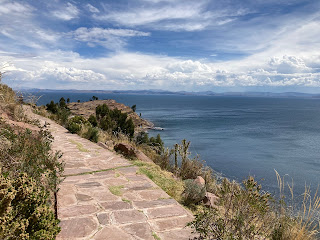November 23rd, 2021
I booked a
day trip boat cruise to a couple of islands on Lake Titicaca, Uros and
Taquile. Lake Titicaca is the highest navigable
lake in the world at 3812 meters and the largest lake in South America. It borders both Peru and Bolivia. I remember as a kid thinking that it was a
funny name for a lake, “Lake Tits ‘n Shit” if you think about it. Okay, back to being an adult.
As I was
sitting in the boat waiting for everyone to board, I was tapped on the shoulder
and heard a familiar voice. It was Eric
and Geraldine from the Colca Canyon trip.
They were planning to do this trip the day before but had fallen ill,
perhaps thanks to some bad food. Sweet,
it will be a more fun day with them for sure.
We left the
dock with about 40 passengers as the guide explained in both Spanish and English
what the plan for the day was. First we
were going to meet the Uru
people on their floating islands and then head further out on the lake to
the island of Taquile.
After 15-20 minutes, the boat was plying through a channel lined with 5-foot-tall reeds on either side, almost like a roadway. It widened and we could see small houses, statues and boats all made from these reeds. We pulled up to one of these floating islands and disembarked. The floor of the islands was completely made of dried reeds and it slightly undulated as waves passed underneath it. Very strange indeed.
Like the Incas, the Urus love the condor:
Our group was asked to sit down on these long “logs” which were also made of reeds in order to have a little introduction to life on these floating islands including how they were constructed. The island we were on probably measured about 80’ by 40’ and was home to 22-26 people. The reeds that surround them are used in so many ways. As I mentioned, the island is made from them. What they do is cut out a meter square section of the floating sedge (almost like peat moss) that the reeds grow on. They drive stakes into them and then tie a bunch of them together. Next they pile reeds on them in one direction, then 90 degrees to that, and back again the other way…over and over until it is about 3 meters deep of reeds! What a lot of work. The islands are in need of constant maintenance and have a lifespan of about 30 years.
Not only
are these reeds used to make the island, the houses, the boats, the benches,
the statues, but you can also eat them!
Eric tried a bit but Geraldine and I opted out. I think we made the right decision as Eric
didn’t seem too impressed. He was a bit
more worried about the lake water that he was ingesting along with it. Can’t blame him. The Urus drink the water, but only after they
have boiled it.
Hard to see, but Eric is still holding his reed, which looked like a massive green onion:
After our
discussion about life on these floating islands (there are about 1200 inhabitants),
we were told to walk around and check out the island. One Uru woman invited 5-6 of us to come and
see her house but as soon as we walked into the small hut, where we barely fit,
we realized we weren’t there to check out how she lived, but what we might want
to buy. There was a table chock full of a
variety of crafts, trinkets and jewelry.
After a few minutes, I thanked the lady and exited the house as I wasn’t
interested in carrying anymore items in my massive paraglider backpack. Eric and Geraldine soon followed suit.
Eric and Geraldine, a captive audience:
I did snap a surreptitious photo of the inside of a lived in house. Note the electrical panel for the solar panels. The whole house can by picked up and transferred to another island.
Back on the
tour boat, we are off to Taquile
Island which was an hour and a half away to the south. The waves got progressively bigger and even a
bit hairier as we rounded to the windward side of the island. “Did they mention where the lifejackets were?”
I wondered. I couldn’t recall the guide saying anything
about them. Oh, that’s okay, we’re only
on the biggest lake in South America with an average water temperature of 12 C…they
did tell us that at least!
We docked
and walked up to a small field beside a small lodge and sat down on a big log
bench (this time, not made from reeds!).
The guide explained a bit about the life of the local Taquileans. About 2200 of them live on the island and a surprisingly
large amount of the info centered on knowing whether someone was married or
not, or whether they had a boyfriend or girlfriend. Married men wore a certain hat, bachelors
another type but if you had a girlfriend you wore the hat a certain way. Similarly with the women, a married woman
always wears a read shirt and black skirt.
You’d think that with only 2200 people, you’d just know through the
grapevine who’s looking and who isn’t…
Our guide explaining some of the Taquilean traditions:
This is a bachelor's hat. It was way too small for me and the other tourists. I guess they have small heads on this island.
Our lunch
was a nice lake trout with rice and veggies.
We walked up to a small, open marketplace where we had 10-15 minutes to
check out their swag. Next, we were treated
to a traditional dance by 15-20 local men and women and then we were asked to
join in. The dance was fairly simplistic
(as was the music), rotating your body slightly from side to side with your
hands going up and down beside you like a bird flapping with the whole group
moving around in a big circle. However,
since we are at 3800 meters above sea level, by the fifth or sixth time around
the circle, I was starting to feel the lack of oxygen. Most tourists must have been feeling it too
as they ducked off to the side but come on people, see it through to the end!
Sorry for the filming...I was too busy dancing:
Me and my new dance partners:
Our boat
picked us up from the leeward side of the island, so we had about a 20-minute
walk over the spine of the island. It
was nice to check out the small farms, planted fields, a small beach and basic infrastructure
of the Taquilean people.
The little stone walls demarcate little farms:
On our boat
ride back to Puno, we were running with the waves and although that is not as
jarring as slamming into waves, it can be unnerving. A couple of times the boat rolled to one side
in the trough of a wave and the water level came up fairly high, almost to the
bottom of the windowsill. Thankfully I
had noticed the lifejackets near the back of the boat as we boarded but man, if
there was a problem, I’m not sure it would be pretty. Forty to fifty people, most of whom probably
can’t swim well or swim at all, in a big cold lake… Just seemed like a disaster waiting to happen.
That
evening I met up with Eric and Geraldine for dinner. Where?
At the same restaurant as yesterday as they also wanted to try out their
good food. It was hard to say no. Reinier and Sibel joined us later which was
great. All of us were taking a night bus
to Cusco. On to the next adventure.
































No comments:
Post a Comment